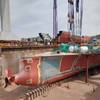Marine Engines Market: $14.4Bln by 2026
The global marine engines market is estimated to grow at CAGR above 4.5% over the forecast time frame 2019 to 2026 and reach the market value around $14.4 billion by 2026.
The shifting trends in the shipping industry and the increase of worldwide amounts of sea trade are projected to fuel the development of the market in marine motors, said a report by Acumen Research and Consulting.
Increased use of low-sulfur fuels due to public emissions reduction standards will fuel demand for the item. The IMO, for example, established rules to tackle sulfur and particulate matter (PM) pollution in January 2015 and limited SOx sales across the ECAs to 0.10%, which complemented the industry's prospects.
Liquefied Natural Gas (LNG) is anticipated to grow significantly by 2026, exceeding USD 2.1 billion. The gas is a complement to vessels and is expected to see a strong supply rise in the next few years.
By decreasing CO2 to around 25 percent, it emits less carbon and is accessible at a competitive cost in commercially feasible areas including Europe and North America. Increasing worldwide trade operations led to more LNG carriers' investment in 2018, which resulted in 10% development in DWT.
Improved living standards and increased disposable revenues underline the growing requirement for ferries and cruises. Low velocity motors are commonly used to strengthen the brand system in merchants, yachts, passengers and business ships. Innovative drive goods to enhance engine effectiveness will also boost the company environment.
Continuing government investment and incentive programs to enhance national security and sophisticated shipping lines are designed to stimulate consumer supply. For example, the US government announced in 2019 that it would spend USD 20 billion to improve the USA Naval Ships. The increase in international trade and the expansion of shipbuilding will promote demand for business ships.
Government’s marine pollution reduction strategies have driven demand for low emission motors. For example, in Annex VI, a directive was adopted by the Marine Environment Protection Committee (MEPC) to limit the NOx emissions of diesel motors with a power output of more than 130 kW.
Progress in technology in the production of sophisticated motors that comply with the established norms will boost company development. Furthermore, positive financial developments from emerging economies are expected to increase the business landscape.
The Middle East industry for marine motors will see significant development in 2025 in excess of USD 800 million. One of the main variables influencing brand acceptance is increasing the accessibility of offshore ships and tankers. Increased exploration and manufacturing operations will boost demand for gas carriers and petroleum tankers along with boat and ships supplying platforms.
Marine motors are used to produce energy for offshore ships, business ships and ships running on a wide range of fuels, including gas oil, diesel petroleum, hybrid and LNG. The main variables responsible for item assembly include fuel efficiency, simple servicing, low damaging emissions, durability, elevated effectiveness and smooth operation.















